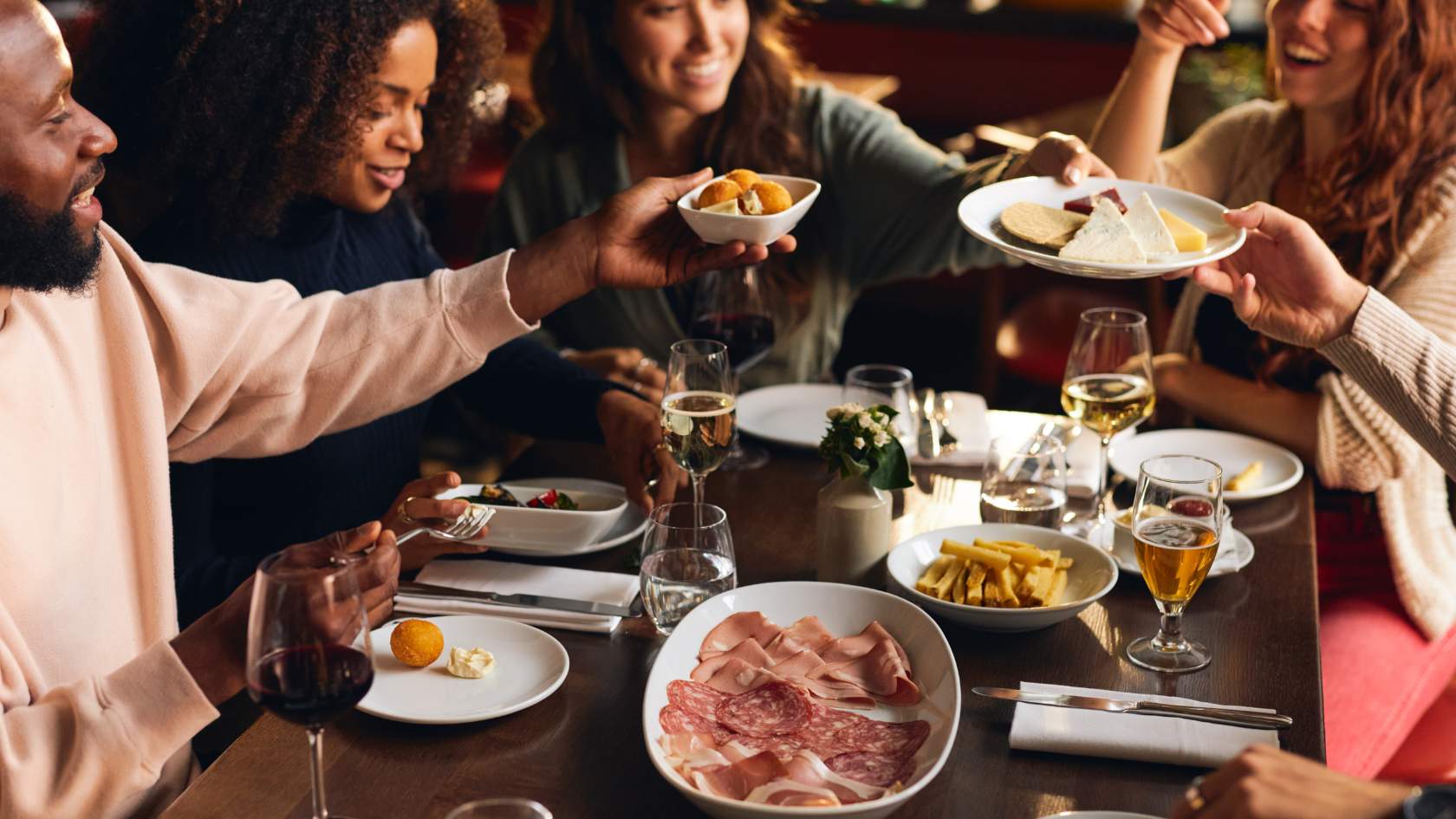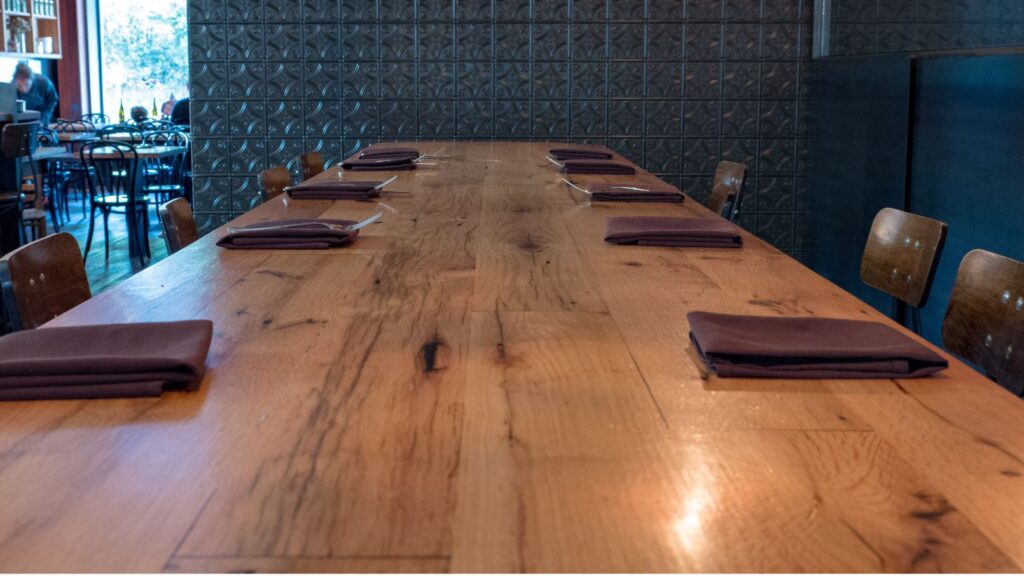The Benefits of Offering Communal Tables and Family-Style Dining

As we make our way into 2024, it’s evident that the dining landscape is evolving by a powerful craving for social connection. People want authentic, tangible connections in a world where digital interactions have often taken precedence. This shift is seen in the dining preferences of consumers.
Communal and family-style dining isn’t just making a comeback; it’s being fully embraced. For restaurant owners and event management professionals, this presents a unique opportunity to cater to growing demand while reaping several business benefits. Let’s look at the pros in offering tables where people can casually gather to enjoy sharable menu items.
What is a Communal Table in a Restaurant?
A communal table at a restaurant is a large table meant to be shared by multiple diners, often those who are not in the same party or do not know each other. The concept behind communal tables is to encourage interaction and socialization among guests, offering a more collective and social dining experience. This type of seating arrangement can be found in various dining establishments, from casual cafes to upscale restaurants, and is designed to create a friendly, open atmosphere where conversation and food can be shared among strangers, turning a meal into a more communal and engaging experience.
What is a Family-style Menu?
A family-style menu in a restaurant or at a dining event features dishes that are served in large, shareable portions, and placed at the center of the table for all diners to share. Unlike individual plating, where each guest receives their own dish, family-style serving encourages communal dining, where everyone helps themselves with the food from common platters and serving dishes. You might use the following terms on your menu to describe these similar menu formats:
- Family-style: Food meant to be passed around and shared.
- Shared Plates: This term suggests that the dishes are designed for the table to share, encouraging a communal dining experience.
- Platters: Often used to describe large dishes served in the middle of the table for everyone to help themselves, platters are synonymous with family-style dining.
- For the Table: This phrase indicates that the dish is intended to be enjoyed by everyone, highlighting its shareable nature.
- Communal Dishes: Similar to family style, this term underscores the communal aspect of dining, where food is meant to be passed around and shared.
- Large Format: This term is often used for dishes significantly larger than typical servings, explicitly designed for groups to share.
- Sharing Menu: Some restaurants offer a separate menu or menu section dedicated to dishes intended for sharing, which may include a variety of small plates or larger, communal dishes.
- Tapas or Mezze: Although specific to Spanish and Middle Eastern cuisines, respectively, these terms have become synonymous with small, shareable plates that are often enjoyed collectively.
- Tasting Menu: This term conveys a sense of special menu options and communal eating, suggesting that the meal is curated and prepared thoughtfully by the chef.

Understanding the Appeal of Family or Group-Style Dining
The appeal of communal and family-style dining is multi-faceted and deeply rooted in the human need for connection and shared experiences. After years of isolation and distance, individuals yearn for belonging and community. Both of these dining styles break down barriers. Communal dining invites strangers to share a meal and stories, turning meals into social experiences rather than solitary events. And for families and groups of friends, family style dining offers a comforting reminder of home-cooked meals, where dishes are passed around and everyone digs in, creating an environment of generosity and abundance. It’s not just about eating; it’s about engaging, sharing, and creating memories.
Customers Desire Community and Social Experiences
- Social Connectivity: In an age where loneliness is often cited as an increasing concern, communal dining offers a remedy, providing a platform for interaction and the formation of new friendships.
- Experience Over Convenience: While fast food and quick-service restaurants have their place, the trend towards experiential dining means guests are looking for more than just a meal—they’re seeking an experience that engages all senses.
- Cultural Exploration: Communal and family-style dining often features diverse cuisines, allowing diners to explore new foods in a way that feels adventurous yet communal and safe.
Indaco – Charleston, SC
Wood-fired pizzas and hand-crafted pasta dominate this restaurant’s menu, offering a selection that can be enjoyed family-style. Indaco’s setting features community tables, an open kitchen, and a comfortable atmosphere, creating an inviting space for guests to gather and dine.
What are the Benefits of Communal Tables to the Business?
Adopting communal and family-style dining concepts offers several tangible benefits for businesses in the hospitality and events sector:
Increased Efficiency and Reduced Costs
- Simplified Menu and Kitchen Operations: Serving dishes family style can streamline kitchen operations. Fewer, larger dishes reduce the complexity of service and plating, allowing kitchens to operate more efficiently.
- Optimized Table Turnover and Space Utilization: Communal tables often accommodate more guests than traditional seating arrangements, optimizing space and potentially increasing turnover rates.
Enhanced Customer Satisfaction and Loyalty
- Unique Dining Experience: Offering communal or family style dining differentiates your establishment, creating memorable experiences that customers are likely to share both online and offline.
Building a Community Around Your Brand: These dining experiences can foster a sense of community among your patrons, encouraging repeat business and building a loyal customer base that feels connected not just to your food, but to the experience and people they meet at your venue.
Marketing and Social Media Buzz
- Instagrammable Moments: The visual appeal of family style platters and the vibrant atmosphere of communal dining are perfect for social media, providing free, user-generated content that can enhance your restaurant’s online presence.
- Storytelling Opportunities: Every communal meal tells a story, offering rich content for your marketing channels, from newsletters to social media posts, highlighting the unique experiences guests can expect.
Zaytinya – DC, NY & South Beach
This Mediterranean restaurant offers wonderful family-style menus, including a tasting menu curated by Zaytinya’s chef and a create-your-own mezze meal. Their long tables can be used as communal and private event tables.
How to Implement Communal and Family-Style at Your Restaurant
For restaurant owners and event managers looking to tap into this trend, consider the following steps:
1. Rethink Your Space
Design your space to accommodate communal tables or flexible dining arrangements that can easily adapt to group sizes.
2. Curate Your Menu
Focus on dishes that can be easily shared and create a sense of abundance on the table. Think about incorporating platters or large-format meals that encourage interaction.
3. Train Your Staff
Ensure your staff understands the ins-and-outs of communal and family-style dining, training them to facilitate guest interactions and explain the shared dining concept enthusiastically.
Embrace the Trend
The rise of communal and family-style dining in 2024 is more than a fleeting trend; it’s a response to a deep-seated desire for connection in an increasingly digital world. For restaurant owners and event managers, this shift presents a golden opportunity to create spaces where people not only come to eat but to connect, share, and leave with more than just a satisfied palate. By embracing this trend, businesses can cater to the human need for connection, creating experiences that resonate with customers on a personal level and foster a sense of community that keeps them coming back for more.
Are you ready to grow your event business? Schedule a Tripleseat demo to take a closer look at our event management features.
